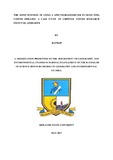Please use this identifier to cite or link to this item:
https://cris.library.msu.ac.zw//handle/11408/3281| Title: | The effectiveness of using a spectroradiometer in detecting coffee diseases: a case study of Chipinge coffee research institute, Zimbabwe | Authors: | Magada, Muchaneta | Keywords: | Agriculture Plant diseases Diseases management |
Issue Date: | 2017 | Publisher: | Midlands State University | Abstract: | Major economic losses in Agriculture worldwide are reported to be caused by plant diseases, therefore diseases management in an accurate and timely manner is of great importance. This study assessed the effectiveness of using a spectroradiometer in detecting coffee diseases (cercospora, CLR). Healthy and diseased plants were used to compare effectiveness of different indices using a spectroradiometer. Results from this study showed that original data from a spectroradiometer does not show pronounced reflectance differences between the healthy coffee plants and the diseased plants. Twenty two known vegetation indices were used to evaluate the reflectance on healthy and diseased coffee plants (plants infected with cercospora, CLR). These indices were evaluated using ANOVA in Genstat 14th Edition and seventeen indices were found to be effective in detecting coffee diseases. The highest significant difference of p<0.001 was found in ten indices. Two sample t-test was performed (on reflectance on healthy plants vs. cercospora, healthy vs. CLR infected plants and CLR vs. cercospora), the indices that were found to be effective, to evaluate their potential in detecting reflectance differences in all the 3 plant states. Results have shown that out of the sixteen indices only six indices were able to detect changes in all the three plant states at (p=0.05) with the highest probability of p<0.001. Indices that were able to differentiate the reflectance of all the three states were regarded as the most effective indices in coffee diseases detection in this study. Results from interviews have also indicated that cercospora and CLR have many detrimental effects on coffee plant growth, yield and quality of coffee product. It is recommended that CORI should adopt the use of remote sensing in the management of coffee diseases, so as to control these diseases before it’s dire. | URI: | http://hdl.handle.net/11408/3281 |
| Appears in Collections: | Bsc Geography And Environmental Studies Honours Degree |
Files in This Item:
| File | Description | Size | Format | |
|---|---|---|---|---|
| R137865P.pdf | Full Text | 695.11 kB | Adobe PDF |  View/Open |
Page view(s)
72
checked on Feb 26, 2025
Download(s)
80
checked on Feb 26, 2025
Google ScholarTM
Check
Items in MSUIR are protected by copyright, with all rights reserved, unless otherwise indicated.


